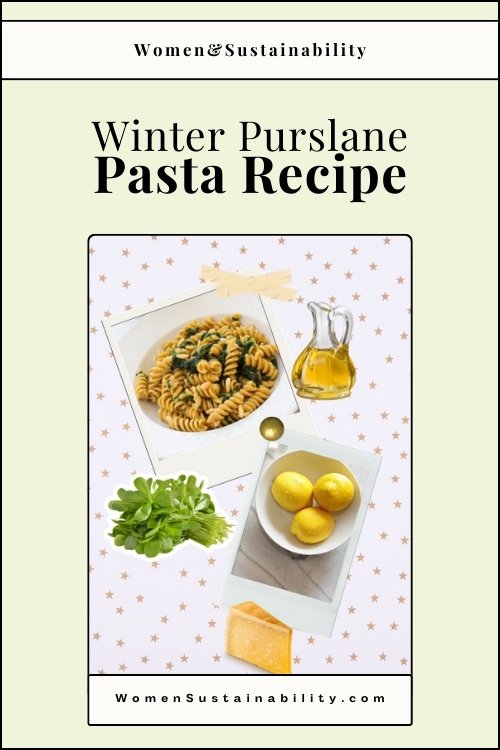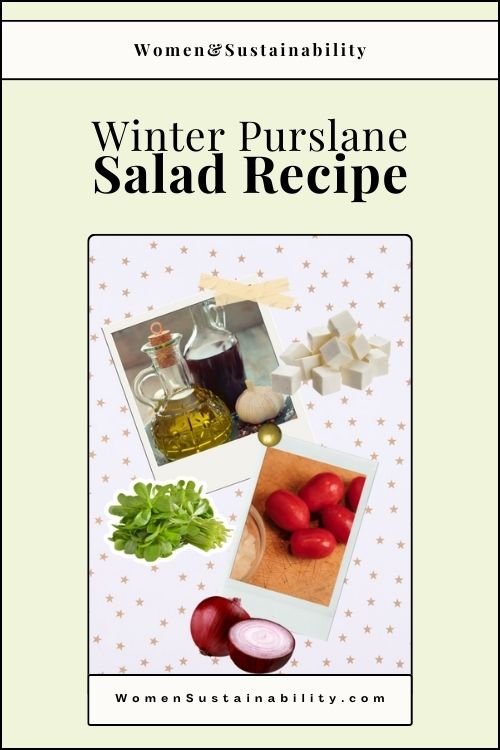Why Winter Purslane is Our New Favorite Green
W&S Home & Lifestyle Editorial Team
SHARE ON:
DISCLAIMER: Please consult a qualified healthcare professional before starting any new supplement regimen. Always seek the advice of your physician or other qualified health provider with any questions you may have regarding a medical condition or dietary supplement. Never disregard professional medical advice or delay in seeking it because of information provided in this article. The content is for informational purposes only and should not be considered a substitute for professional medical advice, diagnosis, or treatment. Always consult with your healthcare provider to address any health concerns you may have. Before reading the following content, we also suggest reading our full disclaimer statement here.
Some of the links on this post might contain affiliate links. If you use any of these links to buy something we may earn a commission. For more information, please check out our disclosure statement. Thanks so much for supporting our free content!
We saw this amazing TikTok from @alexisnikole (check out her content!) and got inspired to make this article about Winter Purslane.
Winter Purslane, often known by its various monikers, has emerged as our newfound favorite for a multitude of reasons. In this exploration, we delve into the world of winter purslane, uncovering its scientific wonders, rich history, and exceptional culinary versatility. From its native roots to its global significance, we present a compelling case for why winter purslane deserves a place on your plate.
In This Article
Not ready to read through just yet? No problem, save it on Pinterest!
What’s “Winter Purslane”?
Winter Purslane, known by various names such as "miner's lettuce," "claytonia," or "Montia perfoliata," is a leafy green vegetable renowned for its unique flavor and nutritional richness. Native to North America, this resilient and cold-hardy plant has found its way into the culinary traditions of various communities worldwide. In this section, we will delve into the scientific profile, origin, cultural significance, and best practices for handling winter purslane.
Scientific Profile of Winter Purslane
Winter Purslane belongs to the Montiaceae family and is scientifically classified as Montia perfoliata. It is a small, succulent annual plant characterized by its rounded leaves and delicate, tender stems. The leaves have a crisp texture and a mild, slightly tart flavor, making them a delightful addition to salads and various dishes.
Native Habitat and Distribution
Winter Purslane is native to North America and thrives in cool, temperate regions. It is commonly found in the western United States, particularly in states like California and Oregon, where it flourishes in moist, shaded areas. Beyond its native habitat, it has also become naturalized in parts of Europe and Asia, where it is cultivated as a cold-season crop.
Cultural Significance
Winter Purslane has been a staple in the culinary traditions of various communities. Indigenous peoples of North America have a long history of using this nutritious green in their diets. It was a valuable source of vitamins and minerals during the winter months when fresh produce was scarce. Today, it continues to be a cherished ingredient in Native American cuisine.
In addition to its North American roots, winter purslane has made its mark in European and Asian cuisines. In Italy, it is known as "portulaca" and is used in salads and various regional dishes. Similarly, it has found a place in Asian cuisine, particularly in China, where it is known as "Ma Chi Xian." Its delicate and slightly tangy flavor complements a wide range of dishes.
Wondering why you’re seeing ads? Check out our Disclosure Policy.
How to Wash and Store Winter Purslane
To maximize the shelf life and freshness of winter purslane, follow these steps:
Harvest and Selection: Choose fresh winter purslane with vibrant green leaves. Avoid any discolored or wilted specimens.
Washing: Rinse the winter purslane under cold, running water to remove dirt and debris. Gently shake or pat it dry with a clean kitchen towel or paper towel.
Storage: Store the washed and dried winter purslane in a perforated plastic bag or airtight container in the refrigerator. This will help maintain its freshness and crispness. It can be stored for up to a week when properly refrigerated.
Winter Purslane's versatility, nutritional value, and cultural significance have made it a cherished green in various culinary traditions. Whether used in salads, stir-fries, or as a garnish, winter purslane's delicate flavor and cold-hardy nature make it a valuable addition to any kitchen.
How Does Winter Purslane Stack Up to Other Greens?
Winter Purslane, scientifically known as Montia perfoliata, is not only a delightful addition to your plate but also a powerhouse of nutrients that can significantly contribute to women's health. Let's delve into its impressive nutritional profile, compare it to other greens, and explore the best ways to harness its benefits through various culinary methods.
Wondering why you’re seeing ads? Check out our Disclosure Policy.
Nutritional Profile of Winter Purslane
Winter Purslane is a nutritional gem, boasting a range of vitamins, minerals, and health-promoting compounds. Its high content of vitamin C, for example, not only supports immune health but also promotes collagen synthesis, essential for maintaining skin elasticity—a key concern for many women.
Furthermore, this leafy green is rich in beta-carotene, a precursor to vitamin A, which plays a crucial role in maintaining healthy vision, skin, and the immune system. Its folate content is vital for women of childbearing age, as it supports fetal development and helps prevent neural tube defects during pregnancy.
Winter Purslane also contains a significant amount of magnesium, which is essential for muscle and nerve function. This mineral may help alleviate common issues like menstrual cramps and PMS symptoms that many women experience.
Comparing Winter Purslane to Other Greens
Winter Purslane's nutritional profile holds its ground when compared to other popular greens like spinach, arugula, and kale. In fact, it often surpasses them in specific aspects:
Vitamin C: Winter Purslane can provide as much, if not more, vitamin C than spinach, aiding in skin health, wound healing, and immune function.
Vitamin A: Its beta-carotene content is comparable to that of spinach, offering ample support for vision and skin health.
Folate: Winter Purslane provides a significant amount of folate, similar to spinach, which is crucial for women of childbearing age.
Magnesium: This leafy green contains a respectable amount of magnesium, contributing to muscle and nerve health, like kale.
Wondering why you’re seeing ads? Check out our Disclosure Policy.
Optimal Ways to Incorporate Winter Purslane
To fully unlock the nutritional benefits of winter purslane, consider the following cooking methods:
Raw: Eating winter purslane raw, such as in salads, preserves its vitamin C content and offers a delightful crunch. It's an excellent way to enjoy its freshness and maximize its skin-boosting benefits.
Cooked: Lightly sautéing or steaming winter purslane can help retain its folate and magnesium while making it more tender. Incorporate it into stir-fries, soups, or sautéed dishes to diversify your nutrient intake.
In summary, winter purslane stands tall among other greens with its impressive nutritional profile. Its richness in vitamins, minerals, and health-enhancing compounds can be particularly beneficial for women. By including it in your diet—whether raw or cooked—you can savor its unique flavor while reaping the rewards of improved skin, vision, and overall well-being.
Winter Purslane Recipes
Explore the culinary possibilities of winter purslane with our diverse selection of recipes. From crisp and refreshing salads to savory pasta dishes and comforting soups, these recipes highlight the versatility and health benefits of this remarkable green. Whether you're a seasoned chef or a cooking enthusiast, these winter purslane recipes offer a delicious way to incorporate this nutritious ingredient into your meals.
Winter Purslane
Soup Recipe
Save on Pinterest & Come Back to It Later →
If you have the Pinterest browser extension, just hover the lefthand corner of this image. If not, do it manually by clicking here!
Like this recipe? Check out our RECIPES board on Pinterest:
Winter Purslane Soup
Prep Time:
Aprx. 15 minutes
Cook Time:
Aprx. 20-25 minutes
Servings:
6 servings
Ingredients:
1 tablespoon olive oil
1 onion, chopped
2 cloves garlic, minced
4 cups vegetable broth
3 cups fresh winter purslane leaves, washed and dried
1 cup diced potatoes
1/2 cup chopped carrots
1/2 cup chopped celery
1 teaspoon dried thyme
Salt and pepper, to taste
1/4 cup heavy cream (optional, for a creamy texture)
*Recipe Notes: Garnish with additional fresh winter purslane leaves or a dollop of sour cream if desired.
Please Note:
Your well-being is essential, and we encourage you to prioritize self-care and make choices that support your mental and physical health. If you think the information provided below has the potential to be in any way harmful or distressing, consider skipping this section and seeking support from a mental health/healthcare professional.
-
(Per serving, without heavy cream)
Calories: 107
Total Fat: 3g
Saturated Fat: 0g
Carbohydrates: 20g
Fiber: 3g
Sugars: 5g
Protein: 2g
Instructions:
In a large pot, heat the olive oil over medium heat. Add the chopped onion and garlic, and sauté until they become translucent.
Pour in the vegetable broth and add the diced potatoes, chopped carrots, and celery. Season with dried thyme, salt, and pepper.
Bring the mixture to a boil, then reduce the heat to a simmer. Cover and cook for about 15-20 minutes or until the vegetables are tender.
Add the fresh winter purslane leaves and cook for an additional 2-3 minutes until they wilt.
If you prefer a creamy soup, stir in the heavy cream at this stage.
Remove the soup from heat and let it cool slightly. Use an immersion blender to puree the soup until smooth. Alternatively, transfer the soup in batches to a blender, blending until smooth, and return it to the pot.
Reheat the soup gently before serving.
Wondering why you’re seeing ads? Check out our Disclosure Policy.
Winter Purslane
Pasta Recipe
Save on Pinterest & Come Back to It Later →
If you have the Pinterest browser extension, just hover the lefthand corner of this image. If not, do it manually by clicking here!
Like this recipe? Check out our RECIPES board on Pinterest:
Winter Purslane Pasta Recipe
Prep Time:
Aprx. 15 minutes
Cook Time:
Approximately 15-20 minutes
Servings:
4 servings
Ingredients:
8 ounces whole wheat pasta
2 cups fresh winter purslane leaves, washed and dried
2 cloves garlic, minced
1/4 cup extra-virgin olive oil
1/4 cup grated Parmesan cheese
Zest and juice of 1 lemon
Salt and black pepper, to taste
Red pepper flakes (optional, for added spice)
*Recipe Notes: This dish is easily customizable with the addition of cooked chicken, shrimp, or your favorite vegetables.
Please Note:
Your well-being is essential, and we encourage you to prioritize self-care and make choices that support your mental and physical health. If you think the information provided below has the potential to be in any way harmful or distressing, consider skipping this section and seeking support from a mental health/healthcare professional.
-
(per serving):
Calories: 367
Total Fat: 17g
Saturated Fat: 3g
Carbohydrates: 44g
Fiber: 5g
Sugars: 2g
Protein: 11g
Instructions:
Cook the whole wheat pasta according to package instructions until al dente. Drain and set aside.
In a large skillet, heat the extra-virgin olive oil over medium heat. Add the minced garlic and sauté for about 1 minute until fragrant.
Add the winter purslane leaves to the skillet and cook for another 2-3 minutes until they begin to wilt.
Toss in the cooked pasta and stir to combine. Add the lemon zest, lemon juice, grated Parmesan cheese, salt, and black pepper. If you like a bit of heat, sprinkle in some red pepper flakes.
Cook for an additional 2-3 minutes, allowing the flavors to meld together.
Serve hot, garnished with extra Parmesan cheese and a drizzle of olive oil if desired.
Winter Purslane
Salad Recipe
Save on Pinterest & Come Back to It Later →
If you have the Pinterest browser extension, just hover the lefthand corner of this image. If not, do it manually by clicking here!
Like this recipe? Check out our RECIPES board on Pinterest:
Winter Purslane Pasta Recipe
Prep Time:
Aprx. 15 minutes
Servings:
4 servings
Ingredients:
2 cups fresh winter purslane leaves, washed and dried
1 cup cherry tomatoes, halved
1/2 cup cucumber, thinly sliced
1/4 cup red onion, finely sliced
1/4 cup crumbled feta cheese
2 tablespoons extra-virgin olive oil
1 tablespoon balsamic vinegar
Salt and pepper, to taste
*Recipe Notes: Feel free to customize your salad by adding free range organic chicken, avocado, or your favorite protein source for a heartier meal.
Please Note:
Your well-being is essential, and we encourage you to prioritize self-care and make choices that support your mental and physical health. If you think the information provided below has the potential to be in any way harmful or distressing, consider skipping this section and seeking support from a mental health/healthcare professional.
-
(per serving, based on 4 servings)
Calories: 165
Total Fat: 12g
Saturated Fat: 3g
Carbohydrates: 11g
Fiber: 2g
Sugars: 4g
Protein: 4g
Instructions:
In a large salad bowl, combine the winter purslane leaves, cherry tomatoes, cucumber, red onion, and crumbled feta cheese.
In a separate small bowl, whisk together the extra-virgin olive oil and balsamic vinegar until well combined. Season with salt and pepper to taste.
Drizzle the dressing over the salad and toss gently to coat all the ingredients evenly.
Serve immediately as a refreshing side dish or a light and nutritious main course.
Wondering why you’re seeing ads? Check out our Disclosure Policy.









